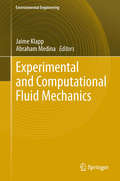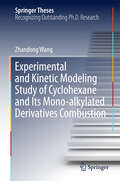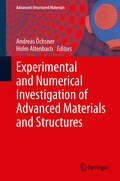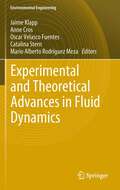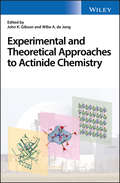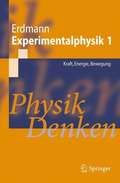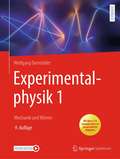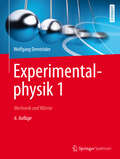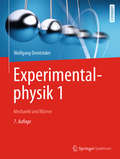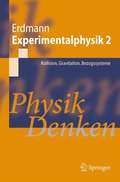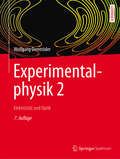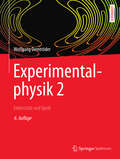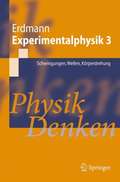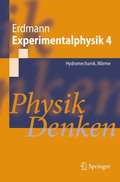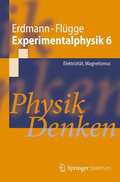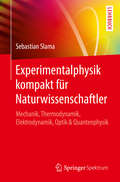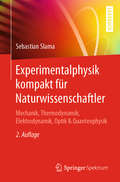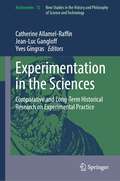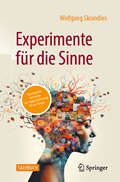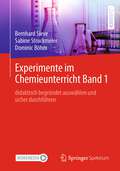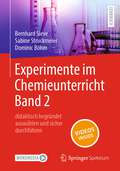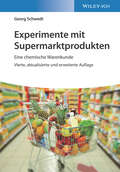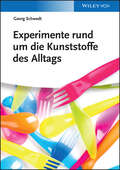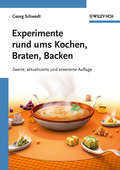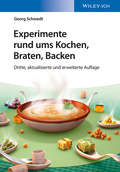- Table View
- List View
Experimental and Computational Fluid Mechanics
by Jaime Klapp Abraham MedinaThis book collects invited lectures and selected contributions presented at the Enzo Levi and XVIII Annual Meeting of the Fluid Dynamic Division of the Mexican Physical Society in 2012. It is intended for fourth-year undergraduate and graduate students, and for scientists in the fields of physics, engineering and chemistry with an interest in Fluid Dynamics from experimental, theoretical and computational points of view. The invited lectures are introductory in nature and avoid the use of complicated mathematics. The other selected contributions are also suitable for fourth-year undergraduate and graduate students. The Fluid Dynamics applications include oceanography, multiphase flows, convection, diffusion, heat transfer, rheology, granular materials, viscous flows, porous media flows and astrophysics. The material presented in the book includes recent advances in experimental and computational fluid dynamics and is well-suited to both teaching and research.
Experimental and Kinetic Modeling Study of Cyclohexane and Its Mono-alkylated Derivatives Combustion (Springer Theses)
by Zhandong WangThis thesis investigates the combustion chemistry of cyclohexane, methylcyclohexane, and ethylcyclohexane on the basis of state-of-the-art synchrotron radiation photoionization mass spectrometry experiments, quantum chemistry calculations, and extensive kinetic modeling. It explores the initial decomposition mechanism and distribution of the intermediates, proposes a novel formation mechanism of aromatics, and develops a detailed kinetic model to predict the three cycloalkanes' combustion properties under a wide range of conditions. Accordingly, the thesis provides an essential basis for studying much more complex cycloalkanes in transport fuels and has applications in engine and fuel design, as well as emission control.
Experimental and Numerical Investigation of Advanced Materials and Structures
by Andreas Öchsner Holm AltenbachThe idea of this monograph is to present the latest results related to experimental and numerical investigations of advanced materials and structures. The contributions cover the field of mechanical, civil and materials engineering, ranging from new modelling and simulation techniques, advanced analysis techniques, optimization of structures and materials and constitutive modelling. Well known experts present their research on damage and fracture of material and structures, materials modelling and evaluation up to image processing and visualization for advanced analyses and evaluation.
Experimental and Theoretical Advances in Fluid Dynamics
by Jaime Klapp Anne Cros Catalina Stern Mario Alberto Rodriguez Meza Oscar Velasco FuentesThe book is comprised of lectures and selected contributions presented at the Enzo Levi and XVI Annual Meeting of the Fluid Dynamic Division of the Mexican Physical Society in 2010. It is aimed at fourth year undergraduate and graduate students, as well as scientists in the fields of physics, engineering and chemistry with an interest in fluid dynamics from the experimental and theoretical point of view. The lectures are introductory and avoid the use of complicated mathematics. The other selected contributions are also geared to fourth year undergraduate and graduate students. The fluid dynamics applications include multiphase flow, convection, diffusion, heat transfer, rheology, granular material, viscous flow, porous media flow, geophysics and astrophysics. The material contained in the book includes recent advances in experimental and theoretical fluid dynamics and will be of great use to those involved in either teaching and/or research.
Experimental and Theoretical Approaches to Actinide Chemistry
by John K. Gibson Wibe A. de JongA review of contemporary actinide research that focuses on new advances in experiment and theory, and the interplay between these two realms Experimental and Theoretical Approaches to Actinide Chemistry offers a comprehensive review of the key aspects of actinide research. Written by noted experts in the field, the text includes information on new advances in experiment and theory and reveals the interplay between these two realms. The authors offer a multidisciplinary and multimodal approach to the nature of actinide chemistry, and explore the interplay between multiple experiments and theory, as well as between basic and applied actinide chemistry. The text covers the basic science used in contemporary studies of the actinide systems, from basic synthesis to state-of-the-art spectroscopic and computational techniques. The authors provide contemporary overviews of each topic area presented and describe the current and anticipated experimental approaches for the field, as well as the current and future computational chemistry and materials techniques. In addition, the authors explore the combination of experiment and theory. This important resource: Provides an essential resource the reviews the key aspects of contemporary actinide research Includes information on new advances in experiment and theory, and the interplay between the two Covers the basic science used in contemporary studies of the actinide systems, from basic synthesis to state-of-the-art spectroscopic and computational techniques Focuses on the interplay between multiple experiments and theory, as well as between basic and applied actinide chemistry Written for academics, students, professionals and researchers, this vital text contains a thorough review of the key aspects of actinide research and explores the most recent advances in experiment and theory.
Experimentalphysik 1
by Martin ErdmannUm Naturvorgänge beobachten, erklären und vorherzusagen zu können, ist die Physik auf fundierte Kenntnisse der experimentellen Methoden, der Interpretation von Messungen und der physikalischen Konzepte angewiesen. Diese werden auf Basis der Mathematik entwickelt. Der Autor vermittelt Physik-Studierenden im Bachelor-Studium die wesentlichen Konzepte und die experimentellen Methoden zu deren Überprüfung. Studierende sollen lernen, die entsprechenden mathematischen Berechnungen anzustellen. Mit Beispielen, Aufgaben und Beschreibungen von Experimenten.
Experimentalphysik 1: Mechanik und Wärme (Springer-Lehrbuch)
by Wolfgang DemtröderDas vorliegende Lehrbuch zur Mechanik und Wärmelehre richtet sich an Studierende der Physik im ersten Semester. Die Vorlesungsinhalte werden hier anschaulich, übersichtlich und leicht verständlich in zwölf Kapiteln dargestellt: Das Buch beginnt mit der Mechanik des Massenpunktes, Bezugssystemen und spezielle Relativitätstheorie. Es werden Systeme von Massenpunkten und die Dynamik starrer ausgedehnter Körper behandelt. Anschließend wird das Verhalten von festen und flüssigen realen Körpern und Gasen diskutiert. Strömende Flüssigkeiten und Gase, Auftrieb und die Physik des Fliegens werden im nächsten Kapitel besprochen. Nach der Vakuum-Physik wird die Wärmelehre eingeführt. Das Buch endet mit mechanischen Schwingungen und Wellen, nichtlinearer Dynamik und Chaos. Für das Verständnis notwendige Teilaspekte der Mathematik werden im Anhang aufgeführt. Ganz im Stil der bekannten Reihe zur Experimentalphysik von Professor Demtröder wird auch die Mechanik und Wärmelehre möglichst quantitativ präsentiert. Wichtige Formeln und Merksätze sind hervorgehoben und der Lernstoff direkt anhand von Beispielen verständlich gemacht. Über 160 Übungsaufgaben werden ausführlich gelöst und Zusammenfassungen unterstützen Studierende beim strukturierten Lernen. In der neunten Auflage des beliebten Lehrbuches erwartet Leserinnen und Leser jetzt zusätzlich: o Wichtige und grundlegende Aufgaben werden in Videos klar und verständlich besprochen und ausführlich an der Tafel gelöst. o Kurze Fragen am Anfang der Kapitel stimmen auf das jeweilige Themengebiet ein und machen neugierig, beispielsweise: Woher wissen wir, dass die Lichtgeschwindigkeit konstant und unabhängig von der Bewegung des Beobachters ist? Was ist ein Trägheitsmoment eines Körpers und wie unterscheidet es sich von der Masse des Körpers? Wovon hängt es ab, ob Materie fest, flüssig oder gasförmig ist? Wie kommt eine Seifenblase zustande? o Ein neues Layout präsentiert den Inhalt noch übersichtlicher. o Ausgesuchte Abbildungen stehen als Vorlesungsfolien für Dozentinnen und Dozenten zur Verfügung. Der Autor Wolfgang Demtröder studierte an den -Universitäten in Münster, Tübingen und Bonn die Fächer Physik, Mathematik und Musikwissenschaft. Dort promovierte er bei dem späteren Nobelpreisträger Prof. Wolfgang Paul. Er arbeitete an der Universität Freiburg als wissenschaftlicher Mitarbeiter, wo er auch habilitiert wurde und forschte als Visiting Fellow am Joint Institute for Astrophysics in Boulder, Colorado und erhielt 1970 einen Ruf als ordentlicher Professor an die Universität Kaiserslautern. Er forschte unter anderem auf dem Gebiet der hochauflösenden Laserspektroskopie kleiner Moleküle. Bekannt ist der Autor vor allem für sein Standardwerk über Laserspektroskopie und seine beliebte und bekannte Lehrbuchreihe Experimentalphysik I-IV.
Experimentalphysik 1: Mechanik und Wärme, 6. Auflage
by Wolfgang DemtröderMECHANIK und WÄRME ist der erste von vier Bänden zur Experimentalphysik von Professor Demtröder. Die Lehrinhalte des ersten Semesters Physik werden anschaulich und leicht verständlich, dabei aber möglichst quantitativ präsentiert. Durchgerechnete Beispiele im Text, Kapitelzusammenfassungen sowie Übungsaufgaben mit ausführlichen Lösungen am Schluss des Buches helfen dabei, den Stoff zu bewältigen, und regen zu eigener Mitarbeit an. Wichtige Definitionen und Formeln, alle Abbildungen und Tabellen wurden zweifarbig gestaltet. Farbtafeln zu ausgesuchten Themen tragen zum Spaß an diesem Buch bei. Die sechste Auflage wurde neu bearbeitet und aktualisiert.
Experimentalphysik 1: Mechanik und Wärme, 7. Auflage
by Wolfgang Demtröder"Mechanik und Wärme" ist der erste von vier Bänden zur Experimentalphysik von Professor Demtröder. Die Lehrinhalte des ersten Semesters Physik werden anschaulich und leicht verständlich, dabei aber möglichst quantitativ präsentiert. Wichtige Definitionen und Formeln, alle Abbildungen und Tabellen wurden zweifarbig gestaltet. Durchgerechnete Beispiele im Text, Kapitelzusammenfassungen sowie Übungsaufgaben mit ausführlichen Lösungen am Schluss des Buches helfen dabei, den Stoff zu bewältigen, und regen zu eigener Mitarbeit an. Die siebte Auflage wurde neu bearbeitet, korrigiert und weitgehend aktualisiert.
Experimentalphysik 2
by Martin ErdmannUm Naturvorgänge beobachten, erklären und vorherzusagen zu können, ist die Physik auf fundierte Kenntnisse der experimentellen Methoden, der Interpretation von Messungen und der physikalischen Konzepte angewiesen. Diese werden auf Basis der Mathematik entwickelt. Der Autor vermittelt Physik-Studierenden im Bachelor-Studium die wesentlichen Konzepte und die experimentellen Methoden zu deren Überprüfung. Studierende sollen lernen, die entsprechenden mathematischen Berechnungen anzustellen. Mit Beispielen, Aufgaben und Beschreibungen von Experimenten.
Experimentalphysik 2: Elektrizität Und Optik
by Wolfgang DemtröderDer zweite von vier Bänden zur Experimentalphysik vermittelt die Lehrinhalte des zweiten Semesters Physik. Durchgerechnete Beispiele im Text, Kapitelzusammenfassungen sowie Übungsaufgaben mit ausführlichen Lösungen am Schluss des Buchs helfen Studierenden, den Stoff zu bewältigen und regen zu aktiver Mitarbeit an. Definitionen und Formeln sowie alle Abbildungen und Tabellen wurden zweifarbig gestaltet, um das Wesentliche deutlicher herauszustellen. Die komplett überarbeitete und ergänzte 6. Auflage wurde für das Bachelor-Studium optimiert.
Experimentalphysik 2: Elektrizität und Optik, 6. Auflage
by Wolfgang DemtrödeDie komplett neu überarbeitete und ergänzte 6. Auflage der Elektrizität und Optik ist der zweite von vier Bänden zur Experimentalphysik von Professor Demtröder. Durchgerechnete Beispiele im Text, Kapitelzusammenfassungen sowie Übungsaufgaben mit ausführlichen Lösungen am Schluß des Buches helfen dabei, den Stoff zu bewältigen, und regen zu eigener Mitarbeit an. Die Lehrinhalte des zweiten Semesters Physik werden nach dem Konzept des ersten Bandes leicht verständlich und dabei möglichst quantitativ präsentiert. Wichtige Definitionen und Formeln sowie alle Abbildungen und Tabellen wurden zweifarbig gestaltet, um das Wesentliche deutlicher herauszustellen. Viele Illustrationen sowie einige Farbtafeln zu ausgesuchten Themen tragen zum Spaß an diesem Buch bei. Die neue Auflage wurde auf das Bachelor-Studium optimiert.
Experimentalphysik 3
by Martin ErdmannUm Naturvorgänge beobachten, erklären und vorherzusagen zu können, ist die Physik auf fundierte Kenntnisse der experimentellen Methoden, der Interpretation von Messungen und der physikalischen Konzepte angewiesen. Diese werden auf Basis der Mathematik entwickelt. Der Autor vermittelt Physik-Studierenden im Bachelor-Studium die wesentlichen Konzepte und die experimentellen Methoden zu deren Überprüfung. Studierende sollen lernen, die entsprechenden mathematischen Berechnungen anzustellen. Mit Beispielen, Aufgaben und Beschreibungen von Experimenten.
Experimentalphysik 4
by Martin ErdmannUm Naturvorgänge beobachten, erklären und vorherzusagen zu können, ist die Physik auf fundierte Kenntnisse der experimentellen Methoden, der Interpretation von Messungen und der physikalischen Konzepte angewiesen. Diese werden auf Basis der Mathematik entwickelt. Der Autor vermittelt Physik-Studierenden im Bachelor-Studium die wesentlichen Konzepte und die experimentellen Methoden zu deren Überprüfung. Studierende sollen lernen, die entsprechenden mathematischen Berechnungen anzustellen. Mit Beispielen, Aufgaben und Beschreibungen von Experimenten.
Experimentalphysik 6: Elektrizität, Magnetismus Physik
by Martin Erdmann Günter FlüggeUm Naturvorgänge beobachten, erklären und vorherzusagen zu können, ist die Physik auf fundierte Kenntnisse der experimentellen Methoden, der Interpretation von Messungen und der physikalischen Konzepte angewiesen. Diese werden auf Basis der Mathematik entwickelt. Der Autor vermittelt Physik-Studierenden im Bachelor-Studium die wesentlichen Konzepte und die experimentellen Methoden zu deren Überprüfung. Studierende sollen lernen, die entsprechenden mathematischen Berechnungen anzustellen. Mit Beispielen, Aufgaben und Beschreibungen von Experimenten.
Experimentalphysik kompakt für Naturwissenschaftler
by Sebastian SlamaDas vorliegende Buch bietet kompakt die Grundlagen der Experimentalphysik für Studierende der Naturwissenschaften, die Physik als Neben- oder Hauptfach belegen. Im Haupttext sind zahlreiche Übungsaufgaben mit vorgerechneten Lösungen eingestreut, und am Ende jedes Kapitels werden die wichtigsten Formeln nochmals aufgelistet. Dieses Buch ermöglicht den Lesern damit, sich einen Überblick über die einzelnen Gebiete zu verschaffen und eignet sich so ideal vorlesungsbegleitend im Studium sowie zur Klausurvorbereitung. Das Lehrbuch ist aus einer Vorlesung zur „Experimentalphysik für Naturwissenschaftler“ an der Universität Tübingen entstanden und richtet sich an alle Studierenden in Fächern wie z.B. Biochemie, Bioinformatik, Biologie, Chemie, Informatik, Mathematik, Pharmazie, Geoökologie und Geowissenschaften. Der erste Teil des Buches beschäftigt sich mit der Newton´schen Mechanik inklusive der Kontinuumsmechanik sowie Schwingungen und Wellen. Im zweiten Teil geht es um die Grundbegriffe der Thermodynamik mit Schwerpunkt auf den statistischen Erklärungen. Der dritte Teil behandelt elektromagnetische Phänomene, insbesondere die Elektro- und Magnetostatik, die Elektrodynamik und eine Einführung in elektronische Bauteile und Schaltungen. Die Optik mit ihren Teilgebieten, Strahlenoptik, Wellenoptik und Quantenoptik, wird im vierten Teil dargestellt. Im fünften und letzten Teil des Buches erhält der Leser abschließend noch einen Überblick über die Grundprinzipien der Quantenmechanik inklusive Atom- und Kernphysik.
Experimentalphysik kompakt für Naturwissenschaftler: Mechanik, Thermodynamik, Elektrodynamik, Optik & Quantenphysik
by Sebastian SlamaDas vorliegende Buch bietet kompakt die Grundlagen der Experimentalphysik für Studierende der Naturwissenschaften, die Physik als Neben- oder Hauptfach belegen. Im Haupttext sind zahlreiche Übungsaufgaben mit vorgerechneten Lösungen eingestreut, und am Ende jedes Kapitels werden die wichtigsten Formeln nochmals aufgelistet. Dieses Buch ermöglicht den Lesern damit, sich einen Überblick über die einzelnen Gebiete zu verschaffen und eignet sich so ideal vorlesungsbegleitend im Studium sowie zur Klausurvorbereitung. Das Lehrbuch ist aus einer Vorlesung zur „Experimentalphysik für Naturwissenschaftler“ an der Universität Tübingen entstanden und richtet sich an alle Studierenden in Fächern wie z.B. Biochemie, Bioinformatik, Biologie, Chemie, Informatik, Mathematik, Pharmazie, Geoökologie und Geowissenschaften. Der erste Teil des Buches beschäftigt sich mit der Newton´schen Mechanik inklusive der Kontinuumsmechanik sowie Schwingungen und Wellen. Im zweiten Teil geht es um die Grundbegriffe der Thermodynamik mit Schwerpunkt auf den statistischen Erklärungen. Der dritte Teil behandelt elektromagnetische Phänomene, insbesondere die Elektro- und Magnetostatik, die Elektrodynamik und eine Einführung in elektronische Bauteile und Schaltungen. Die Optik mit ihren Teilgebieten, Strahlenoptik, Wellenoptik und Quantenoptik, wird im vierten Teil dargestellt. Im fünften und letzten Teil des Buches erhält der Leser abschließend noch einen Überblick über die Grundprinzipien der Quantenmechanik inklusive Atom- und Kernphysik.Für die vorliegende zweite Auflage sind die Inhalte an vielen Stellen verbessert und ergänzt worden, darunter finden sich unter anderem ein neuer Abschnitt zum Wärmetransport und zu Phasenübergängen sowie ein Ausblick in alternative Interpretationen der Quantenmechanik.
Experimentation in the Sciences: Comparative and Long-Term Historical Research on Experimental Practice (Archimedes #72)
by Yves Gingras Catherine Allamel-Raffin Jean-Luc GangloffThis book takes a novel approach by highlighting comparative and long-term historical perspectives on experimental practice. The juxtaposition of accounts of natural, social, and medical experimentation is very enlightening, especially because the authors put the emphasis on the different kinds of objects of experimentation (physical matter, chemical reagents, social groups, organizations, sick individuals, archeological remains) and demonstrate how much the kinds of objects matter for the practice of experimentation, its methods, tools, and methodologies. Taken together, the chapters raise several fascinating questions for further study: What do these different approaches have in common? Why do we call them “experimentation”? What are the intersections among the fields and their developments? The volume engages philosophical approaches that are not well known to Anglophone readers (Bachelard, Bergson, Bernard, Canguilhem, among others) and brings to attention a wealth of Francophone secondary literature on past and present scientific experimentation. The collection fills a yawning gap in science, science studies, and philosophy of science teaching, making it particularly valuable philosophers and historians of science in all subfields.
Experimente für die Sinne: spannende Versuche zur Wahrnehmung für zu Hause
by Wolfgang SkrandiesHaben Sie sich auch schon einmal gefragt, warum Sie eine Gänsehaut bekommen, wenn Sie in ein zu heiß eingelassenes Entspannungsbad steigen? Oder warum Sie Ihre Nase oder den Rahmen Ihrer Brille normalerweise nicht wahrnehmen? Vielleicht möchten Sie aber auch selbst erleben, wie Ihre Nase scheinbar immer länger wird, ähnlich wie bei Pinocchio? Dieses Sachbuch bietet eine fesselnde Reise durch die verschiedenen Bereiche unserer Sinneswahrnehmung. Es widmet sich ausführlich den Bereichen Sehen, Hören, Fühlen, Riechen sowie Schmecken und zeigt, wie diese Sinne unser tägliches Leben beeinflussen. Das Buch beginnt mit einem einführenden Kapitel, das die Grundlagen der Sinnesphysiologie kurz umreißt. Von dort aus ist es in Kapitel unterteilt, die jeweils einem spezifischen Sinnessystem gewidmet sind. Der Autor präsentiert knapp, aber dennoch ausführlich genug, die physiologischen und anatomischen Fakten, die unsere Wahrnehmungen erklären. Das Herzstück des Buches sind jedoch die kleinen Experimente, die zu den verschiedenen Modalitäten passen und mit einfachen Haushaltsgegenständen durchgeführt werden können. Diese Experimente ermöglichen es den Lesern, die besprochenen Phänomene direkt zu erleben und sie in Staunen zu versetzen. Das Buch richtet sich an ein breites Publikum, von interessierten Laien bis hin zu Studierenden der Psychologie, Medizin oder Biologie. Durch die Vermeidung komplexer Beschreibungen kann es sogar im Schulunterricht eingesetzt werden, um den Unterricht in Biologie oder Physik zu bereichern.
Experimente im Chemieunterricht Band 1: didaktisch begründet auswählen und sicher durchführen
by Bernhard Sieve Sabine Struckmeier Dominic Böhm„Welches von den vielen Experimenten soll ich denn nun nehmen? Wie ordne ich die Experimente sinnvoll in einer Unterrichtsreihe an? Was muss ich bei der Durchführung bedenken?“ Wenn Sie sich als Lehramtsstudierende*r, Lehrkraft im Vorbereitungsdienst, Chemie fachfremd unterrichtende Lehrkraft oder frisch eingestellte Chemielehrkraft diese oder ähnliche Fragen bei der Planung Ihres Chemieunterrichts stellen, halten Sie gerade die ideale Planungshilfe in den Händen. Auch „alte Hasen“ können mit dieser Handreichung ihr Repertoire an Experimentierkunst erweitern.Die zwei Bände Experimente im Chemieunterricht enthalten eine Sammlung von nahezu 400 praxiserprobten Schulexperimenten für den Chemieunterricht der Sekundarstufen I und II. Darüber hinaus sind zu jedem Experiment Durchführungshinweise und Gefährdungseinstufungen, Anregungen zur inhaltlichen Strukturierung des jeweiligen Unterrichtsthemas sowie Angaben zur fachlichen und fachdidaktischen Einbettung aufgeführt. Videos zur Handhabung ausgewählter Geräte sowie zu zentralen Arbeitsweisen der Chemie unterstützen die Gestaltung eines sicheren und gefahrenminimierten Chemieunterrichts. Als weiteres digitales Zusatzmaterial wird zu jedem Experiment eine editierbare Word-Version bereitgestellt. Diese einzigartige Kombination von experimenteller und fachlich-fachdidaktischer Betrachtung hilft Ihnen bei der begründeten Auswahl von Experimenten sowie bei deren sachgerechter Einbindung in die jeweilige Unterrichtsreihe und schafft so eine wesentliche Voraussetzung für gelingenden Chemieunterricht.Experimente im Chemieunterricht – ein Muss für jede Chemielehrkraft!
Experimente im Chemieunterricht Band 2: didaktisch begründet auswählen und sicher durchführen
by Bernhard Sieve Sabine Struckmeier Dominic Böhm„Welches von den vielen Experimenten soll ich denn nehmen? Wie ordne ich die Experimente sinnvoll in meinem Unterricht an? Was muss ich bei der Durchführung bedenken?“ Wenn Sie sich als Lehramtsstudierende*r, Lehrkraft im Vorbereitungsdienst, Chemie fachfremd unterrichtende Lehrkraft oder frisch eingestellte Chemielehrkraft diese oder ähnliche Fragen bei der Planung Ihres Chemieunterrichts stellen, halten Sie gerade den zweiten Band einer idealen Planungshilfe in den Händen. Auch „alte Hasen“ können mit den zwei Bänden ihr Repertoire an Experimentierkunst erweitern.Die zwei Bände Experimente im Chemieunterricht enthalten eine Sammlung von über 400 praxiserprobten Schulexperimenten für den Chemieunterricht der Sekundarstufen I und II. Darüber hinaus sind zu jedem Experiment Durchführungshinweise und Gefährdungseinstufungen, Anregungen zur inhaltlichen Strukturierung des jeweiligen Unterrichtsthemas sowie Hinweise zur fachlichen und fachdidaktischen Einbettung aufgeführt. Videos zur Handhabung ausgewählter Geräte sowie zu zentralen Arbeitsweisen der Chemie unterstützen die Gestaltung eines gefahrenminimierten Chemieunterrichts. Als weiteres digitales Zusatzmaterial wird zu jedem Experiment eine editierbare Word-Version bereitgestellt. Über einen Verweis zur Datenbank DEGINTU können sie zudem Gefährdungsbeurteilungen zu zahlreichen Experimenten abrufen.Diese einzigartige Kombination von experimenteller und fachlich-fachdidaktischer Betrachtung hilft Ihnen bei der zielführenden Auswahl geeigneter Experimente für das jeweilige Unterrichtsthema und schafft damit eine zentrale Voraussetzung für lernwirksamen Chemieunterricht. Experimente im Chemieunterricht Band 1 und Band 2 – ein Muss für jede Chemielehrkraft!
Experimente mit Supermarktprodukten: Eine chemische Warenkunde
by Georg SchwedtChemie ist überall, man muss nur danach suchen! Mithilfe einfachster Experimente zeigt der Autor, wieviel Chemie in den täglichen Einkäufen aus dem Supermarkt oder aus dem Baumarkt steckt, vom Puddingpulver bis zur Zahncreme. Die vierte Auflage dieses Klassikers ist um ein Kapitel zur Chemie der Schreibwaren und Büroartikel erweitert, in dem unter anderem Klebstoffe und Farbstifte unter die chemische Lupe kommen. Ideal für alle, die gerne experimentieren und schon einmal ein Reagenzglas in der Hand gehalten haben sowie für alle, die auf anschauliche Weise Chemie vermitteln wollen. "... Wenn Sie schon immer einmal wissen wollten, warum Rotkohlsaft ein guter Indikator für den pH-Wert ist, wie Sie selber Kunsthonig herstellen können, wie sich echter und falscher Lachs experimentell unterscheiden lassen und was in Farbmalstiften so alles enthalten ist." (WDR 5, Leonardo - Wissenschaft und mehr)
Experimente rund um die Kunststoffe des Alltags
by Georg SchwedtJoghurtbecher, Frischhaltefolien, Plastikbeutel, Parkbänke, Wärmedämmungs- und Verpackungsmaterialien und, und, und ... ohne Kunststoffe geht es in unserem Alltag nicht! Georg Schwedt, erfolgreicher Sach- und Lehrbuchautor, präsentiert ein neues und in seiner Thematik einzigartiges Experimente-Buch. Seit mehreren Jahrzehnten wirbt Georg Schwedt für die Chemie. Den Aufbau und Betrieb mehrerer Mitmachlabors hat er maßgeblich initiiert und mitgestaltet - die daraus gewonnene Erfahrung fließt auch in die Gestaltung jedes der mehr als 70 Experimente ein. Wie in seinen anderen Experimentierbüchern sind die Materialien - die Palette reicht von Biopolymeren bis zu vollsynthetischen Kunststoffen - problemlos zu besorgen und die Untersuchungen sind ungefährlich und einfach nachzuvollziehen. Wie kann man das Material eines Joghurtbechers von dem eines Zahnputzbechers unterscheiden? Was kann man mit dem Superabsorber einer Babywindel so alles Sinnvolles anstellen? Nach der Lektüre dieses Buches wissen Sie mehr! Und den Spaß beim lehrreichen Experimentieren gibt es kostenlos dazu! Ein Buch für Lehrer und Schüler der Mittel- und Oberstufe, Dozenten, Studenten und überhaupt für Alle an Chemie Interessierte.
Experimente rund ums Kochen, Braten, Backen
by Georg SchwedtDie Küche - ein chemisches Laboratorium? In der neuen Auflage des Erfolgstitels von Georg Schwedt wird das Kochen, Braten und Backen aus ungewohnter Perspektive unter die Lupe genommen. Die Abläufe in der Küche beschränken sich nicht nur auf Rühren, Kneten und Bestreichen eines Kuchens mit Glasur. - Nein, beim Kochen, Backen und Braten laufen komplizierte chemische Reaktionen ab, die Auswirkungen auf den Geschmack, Geruch und andere Eigenschaften des Essens haben. Wie brät man am besten das Schnitzel, damit es nicht zum zähen Stück Fleisch gerät? Wann mischt man die Gewürze unter die Suppe oder an das Gemüse, um das volle Aroma zu erhalten? Warum kleben Nudeln aneinander? Wieso bleiben Erbsen saftig grün, nachdem man sie abgeschreckt hat? Dieses und mehr führt Schwedt spielerisch anhand von Alltagsexperimenten vor. Kochen macht Spaß und chemisches Experimenten auch - beides verbindet dieses Buch. Diesmal auch mit einer Molekular- und Suppenküche! Stimmen zur ersten Auflage: "Was das Buch für den Chemielehrer interessant macht ist die Systematik und die Erläuterung der Hintergründe. Es ist keine trockene Lektüre? sondern durch die umfangreichen Zitate und die anekdotischen Bereicherungen eine flüssig zu lesende Lektüre, die gute Anregungen für Unterrichtsexperimente liefert." Praxis der Naturwissenschaften - Chemie in der Schule "Das Buch vermittelt auf spielerische Art fundiertes Wissen zur Aufklärung von Alltagsphänomenen rund ums Kochen, Backen, Braten." BG Chemie und Hauptverband der gewerblichen Berufsgenossenschaften "Chemische - und damit geschmackliche - Veränderungen von Nahrungsmitteln im Rahmen einer Systematik der Garprozesse sind das Thema des Buches, und damit bildet es das chemische Rückgrat guten Kochens." Chemie in Labor und Biotechnik
Experimente rund ums Kochen, Braten, Backen
by Joachim SchreiberDie Kuche - ein chemisches Laboratorium? In der neuen Auflage des Erfolgstitels von Georg Schwedt wird das Kochen, Braten und Backen aus ungewohnter Perspektive unter die Lupe genommen. Die Ablaufe in der Kuche beschranken sich nicht nur auf Ruhren, Kneten und Bestreichen eines Kuchens mit Glasur. - Nein, beim Kochen, Backen und Braten laufen komplizierte chemische Reaktionen ab, die Auswirkungen auf den Geschmack, Geruch und andere Eigenschaften des Essens haben. Wie brat man am besten das Schnitzel, damit es nicht zum zahen Stuck Fleisch gerat? Wann mischt man die Gewurze unter die Suppe oder an das Gemuse, um das volle Aroma zu erhalten? Warum kleben Nudeln aneinander? Wieso bleiben Erbsen saftig grun, nachdem man sie abgeschreckt hat? Dieses und mehr fuhrt Schwedt spielerisch anhand von Alltagsexperimenten vor. Kochen macht Spa und chemisches Experimenten auch - beides verbindet dieses Buch. Diesmal auch mit einer Molekular- und Suppenkuche Stimmen zur ersten Auflage: "Was das Buch fur den Chemielehrer interessant macht ist die Systematik und die Erlauterung der Hintergrunde. Es ist keine trockene Lekture? sondern durch die umfangreichen Zitate und die anekdotischen Bereicherungen eine flussig zu lesende Lekture, die gute Anregungen fur Unterrichtsexperimente liefert. " Praxis der Naturwissenschaften - Chemie in der Schule "Das Buch vermittelt auf spielerische Art fundiertes Wissen zur Aufklarung von Alltagsphanomenen rund ums Kochen, Backen, Braten. " BG Chemie und Hauptverband der gewerblichen Berufsgenossenschaften "Chemische - und damit geschmackliche - Veranderungen von Nahrungsmitteln im Rahmen einer Systematik der Garprozesse sind das Thema des Buches, und damit bildet es das chemische Ruckgrat guten Kochens. " Chemie in Labor und Biotechnik
